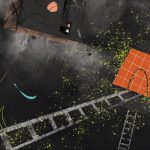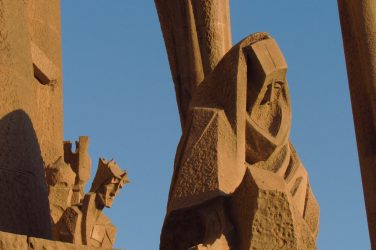The Tbilisi cityscape is in equal parts beautiful and chaotic. Taking us along into the Georgian capital, Laura Worsch writes about Tbilisian urban planning and her conversation with Gigi Shukakidze, architect and co-founder of the Tbilisi Architecture Biennial (TAB).
The past three months were quiet in Georgia. Due to Corona, the government had declared a night curfew, in addition to a general lockdown of large parts of the economy. The streets were empty, most construction sites stopped working, and suddenly you could hear birds singing in the morning. The busy capital Tbilisi with more than one million citizens at times seemed more like a village. All the more shocking is the contrast now that everything starts to “open up” again: Traffic seems to be worse than before, or maybe we are just more sensible towards the smell, noise, and big crowds now. It also sharpens the view for Tbilisi’s problems with traffic and construction that seem to lack any plan. Construction sites pop up like daisies, while unfinished concrete skeletons decorate nearly every district.

“Since 2019, Tbilisi actually has a new general master plan”, says Gigi Shukakidze, architect, co-founder of the Tbilisi Architecture Biennial (TAB) and founder of architecture practice Wunderwerk. “It is the first official city plan since the 1980s.” After the dissolution of the Soviet Union, construction projects appeared rather chaotically, and lack of regulations allowed landowners to build even higher buildings, as long as they paid enough. The new general master plan means to restrict this practice and additionally aims to increase sustainable urban development and the protection of cultural heritage. While some aspects of the plan – like the establishment of four new parks in Tbilisi – seem to be fulfilled, the chaotic continuation of construction and megalomaniac projects are witness that the plan only scratches the surface of uncontrolled building in the Georgian capital.
One example is the Panorama Tbilisi project, a huge construction complex of four hotels and office block towers which stretch from the city centre to the Sololaki mountain just outside Tbilisi. Starting construction in 2014, it has been criticized for environmental threats such as landslides, as well as for the ties some politicians have to the companies involved. Protests under the slogan ‘PaNOrama’ have repeatedly tried to stop construction, but without luck.
It is not the only example of the lack of strategy and ignorance towards the monumental heritage of Tbilisi. “The remodeling of rundown places is important”, stresses Shukakidze. “But most projects don’t take into account the common needs of the community and turn these old buildings into hotels or shopping centres.” While small grocery shops and vegetable road stands are an integral part of the cityscape of Tbilisi, the emergence of big supermarket chains increasingly endanger these small businesses.
On the plus side, initiatives and movements have successfully been opposing and monitoring the municipality’s construction mismanagement. In 2018, years of protests prevented the construction of a hotel in Vake Park, one of Tbilisi’s green jewels. Especially when it comes to protecting their green zones and parks, Tbilisians have repeatedly shown their engagement. Many backyard parks are managed and taken care of by the neighbourhood itself, representing hidden, microscopic oases in a concrete jungle. In these backyards, children are raised, the elderly play backgammon, and the noise of the streets seems to be absorbed by the panel buildings surrounding them. Meanwhile, the municipality itself wants to finish the remodeling of 12 big parks in Tbilisi by the end of 2020, which have been neglected and run-down.
“Many of today’s parks have been established during the Soviet period”, says architect Shukakidze. “In a totalitarian mode, the original phenomenon of commonness has been reflected in public space in its own way.” After 1990, the formerly collectivist societies became increasingly individualized, and new socio-economic processes changed cityscapes in all post-Soviet countries, which also led to the destruction of the overall quality of the park spaces. In the early 2000s, this changed due to pro-American and Western influence and a new sense of openness set in: “The motto was: ’Everything should be transparent!’ This is why we have police stations built out of glass”, recalls Shukakidze. “In this Hollywood-like scenario the trend was to build more public squares with big fountains to make people “happy”.” The municipality’s engagement nowadays is, according to him, mainly motivated by attracting votes. “But still, it connects people. Green spaces in Tbilisi are a big part of our commonness.”

Commonness is also the topic of this year’s Tbilisi Architecture Biennial that first took place in 2018. Founded by Tinatin Gurgenidze, Natia Kalandarishvili, Otar Nemsadze and Gigi Shukakidze, it provides a critical platform to architecture. “There was no architectural magazine or other format to discuss architecture, urbanism or city planning in Georgia”, explains Shukakidze. Through symposiums, lectures, indoor / outdoor exhibitions, guided tours and film screenings, the Biennial last year addressed the topic of informal architecture. This year, it will take place fully online, with events spread throughout the whole month of November. Even though it focuses on local topics, the Biennial works together with partners from Germany, Macedonia and Ukraine and receives funds from the EU program “Creative Europe”. “Key piece of the Biennial will be the prototype of a digital building, which will represent the different activities and which can be realized anywhere in the world during the TAB 2020”, says Shukakidze. Every floor and room will represent one event and be designed accordingly. As described in their open call, Commonness “unites open resources of any kind: natural, cultural, spatial, material and immaterial – of which ownership and access is shared.” In this sense, common spaces not only include public parks, but also neighbourhood backyards, staircases or roofs of residential blocks.
The topic of Commonness is even more relevant for the organizers in the context of COVID-19, since the virus has raised awareness of the importance of community, solidarity, and shared spaces. “It maybe sounds dark, but many things became much more clear during this period”, says the architect. In his opinion, the green spaces of Tbilisi can, in the long run, only be preserved through public-private partnerships, since the public sector alone often seems inefficient. “Concerning the preservation and protection of common spaces, the government, developers, professionals and communities should work together”, demands Shukakidze.
Cover photo: falco (Pixabay), Pixabay licence










